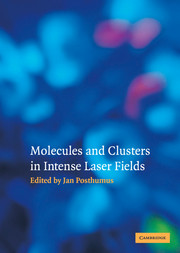Book contents
- Frontmatter
- Contents
- Preface
- 1 Ultra-high-intensity lasers based on Ti: sapphire
- 2 Diatomic molecules in intense laser fields
- 3 Small polyatomic molecules in intense laser fields
- 4 Coherent control in intense laser fields
- 5 Experimental studies of laser-heated rare-gas clusters
- 6 Single-cluster explosions and high-harmonic generation in clusters
- 7 Interactions of intense laser beams with extended cluster media
- Index
7 - Interactions of intense laser beams with extended cluster media
Published online by Cambridge University Press: 29 March 2010
- Frontmatter
- Contents
- Preface
- 1 Ultra-high-intensity lasers based on Ti: sapphire
- 2 Diatomic molecules in intense laser fields
- 3 Small polyatomic molecules in intense laser fields
- 4 Coherent control in intense laser fields
- 5 Experimental studies of laser-heated rare-gas clusters
- 6 Single-cluster explosions and high-harmonic generation in clusters
- 7 Interactions of intense laser beams with extended cluster media
- Index
Summary
Introduction
As outlined in earlier chapters, there is currently considerable interest in the interaction of intense, short-duration laser pulses with isolated atomic clusters. Some of the more spectacular recent results reported in the literature have included the observation of mega-electron-volt ions, multi-kilo-electron-volt electrons and extremely high charge states of ions in laser–cluster-interaction experiments. It is clear that, whilst aggregates of more than a few hundred atoms in strong laser fields share some aspects of both solid and monatomic gas-target behaviours, they also exhibit new and quite startling effects that are very specific to atomic clusters. In particular the interaction is extremely energetic compared with that of small molecules and aggregates of a few tens of atoms, for which field and multi-photon ionisation dominate and ions are typically accelerated to energies of only a few tens of electron-volts in weak Coulomb explosions.
An important question to ask is ‘does the energetic behaviour seen in single-cluster experiments hold for extended cluster media, in which a laser pulse interacts with many billions of clusters at the same time and interactions between adjacent clusters become important?’. Are there interesting propagation effects, for example, and can we enhance coherent processes such as high-harmonic generation in cluster media? Finally, can we harness the large energies of ions available from single-cluster interactions for use in heating significant volumes of material to drive applications such as the production of X-rays and thermonuclear fusion.
- Type
- Chapter
- Information
- Molecules and Clusters in Intense Laser Fields , pp. 216 - 257Publisher: Cambridge University PressPrint publication year: 2001
- 3
- Cited by

